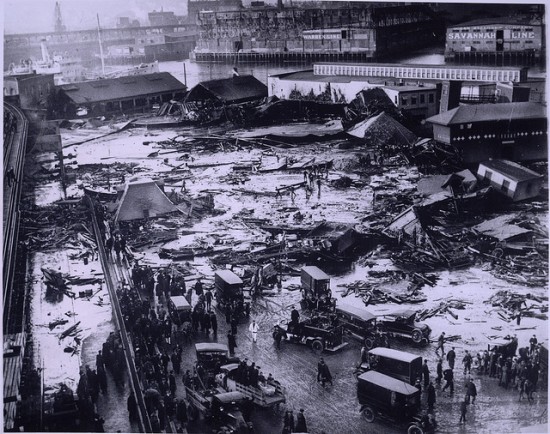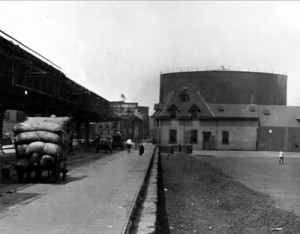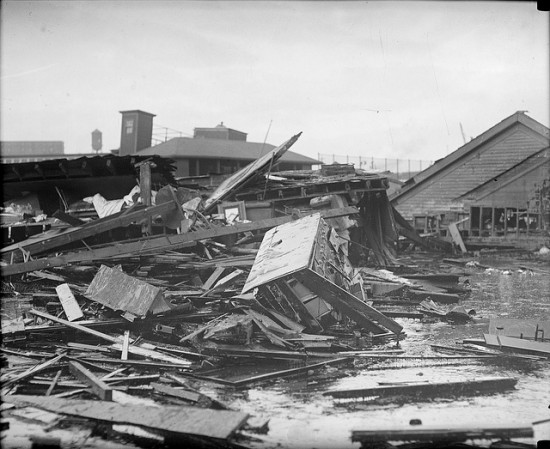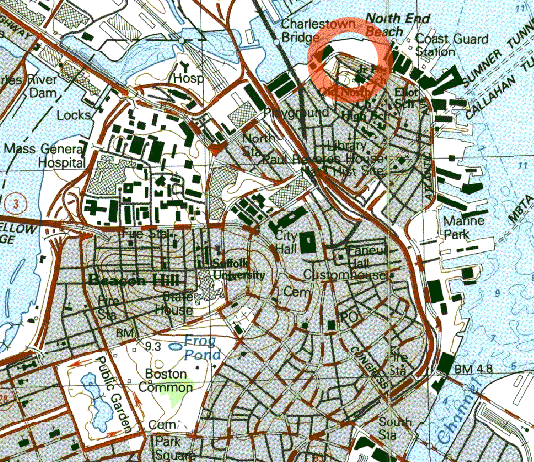This is one of those stories that seems unreal, but it is true. There was actually a flood of molasses that swept through the streets at 35 MPH. Here's the details from Wikipedia:
Near Keany Square,[4] at 529 Commercial Street, a huge molasses tank 50 ft (15 m) tall, 90 ft (27 m) in diameter and containing as much as 2,300,000 US gal (8,700 m3) collapsed. Witnesses stated that as it collapsed, there was a loud rumbling sound, like a machine gun as the rivets shot out of the tank, and that the ground shook as if a train were passing by.
The collapse unleashed an immense wave of molasses between 8 and 15 ft (2.5 and 4.5 m) high, moving at 35 mph (56 km/h), and exerting a pressure of 2 ton/ft² (200 kPa). The molasses wave was of sufficient force to damage the girders of the adjacent Boston Elevated Railway's Atlantic Avenue structure and tip a railroad car momentarily off the tracks. Nearby, buildings were swept off their foundations and crushed. Several blocks were flooded to a depth of 2 to 3 feet (60 to 90 cm). As described by author Stephen Puleo:
Molasses, waist deep, covered the street and swirled and bubbled about the wreckage. Here and there struggled a form — whether it was animal or human being was impossible to tell. Only an upheaval, a thrashing about in the sticky mass, showed where any life was… Horses died like so many flies on sticky fly-paper. The more they struggled, the deeper in the mess they were ensnared. Human beings — men and women — suffered likewise.
The Boston Globe reported that people "were picked up by a rush of air and hurled many feet." Others had debris hurled at them from the rush of sweet-smelling air. A truck was picked up and hurled into Boston Harbor. Approximately 150 were injured; 21 people and several horses were killed — some were crushed and drowned by the molasses. The wounded included people, horses, and dogs; coughing fits became one of the most common ailments after the initial blast.
Wired reports on the blame game and that the North End smelled of molasses for quite a while:
It was the height of the post-World War I Red Scare, and the distillery blamed anarchists, who they said knew the molasses was intended for alcohol to make military ammunition. The victims and their survivors blamed the distillery for faulty construction and unsafe operation.
More than a hundred separate lawsuits dragged on until 1925, when the U.S. Industrial Alcohol Co., the distillery's owner, finally settled the claims for nearly $1 million (about $12 million in today's money).
One of the strangest industrial accidents ever lingered on, and not just in a few safety improvements. On warm days for decades after, the neighborhood smelled of molasses. And if you listen to old-timers, even today, hot weather brings a vague, sickly sweet smell to the streets of the North End.
Real News Real History Summary
This is a really good clip to watch that summarizes what happened before and after the spill. Great stuff!
Pictures from the Boston Public Libraray
Here's a slideshow from the BPL Flickr set the above pictures are from:




